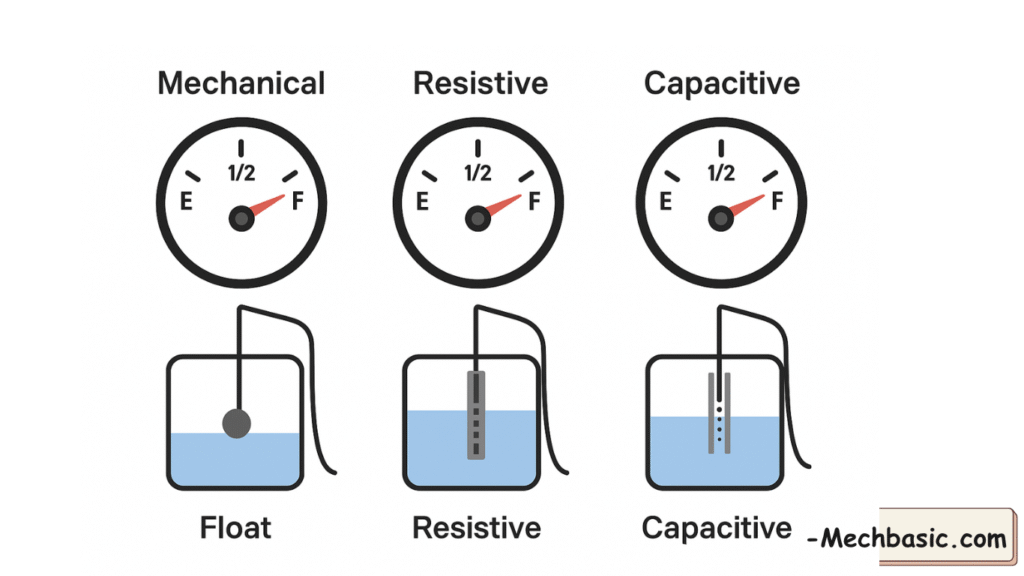Let’s go in detail about the types of fuel gauges in automobiles:
1. Overview of Fuel Gauges
A fuel gauge measures the amount of fuel in the tank and displays it on the dashboard.
Fuel gauges are mainly classified based on their mechanism and display type.
2. Types of Fuel Gauges

A. Mechanical / Analog Fuel Gauge
How it Works:
- Uses a float in the fuel tank that rises or falls with the fuel level.
- The float is connected to a variable resistor (potentiometer).
- The resistance changes as the float moves, altering the current sent to the gauge.
- The needle on the dashboard moves accordingly to indicate fuel level (E = Empty, F = Full).
Features:
- Simple and reliable.
- No microelectronics required.
- Gradual needle movement for smooth visual indication.
Advantages:
- Robust and inexpensive.
- Easy to repair.
Disadvantages:
- Can become inaccurate over time due to wear on the float or resistor.
- Limited integration with digital systems.
B. Electronic / Digital Fuel Gauge
How it Works:
- Uses a fuel level sensor (float or capacitive) to measure fuel.
- Sensor sends electrical signals to the ECU or dashboard display.
- Digital display can show bar graph, percentage, or numerical value of fuel remaining.
Features:
- Integrated with modern ECU and trip computers.
- Can provide accurate readings even at low fuel levels.
- Can include fuel consumption and range estimation.
Advantages:
- Accurate and easy to read.
- Integrates with other vehicle systems (trip meter, fuel economy).
- Can trigger automatic low fuel warnings.
Disadvantages:
- More complex and expensive to repair.
- Relies on electrical components and sensors that may fail.
C. Capacitive / Advanced Fuel Gauge
How it Works:
- Measures fuel level using a capacitive probe inside the tank.
- Fuel acts as a dielectric material; capacitance changes as fuel level changes.
- Signal sent to ECU and displayed digitally on dashboard.
Features:
- Very accurate, even with irregular-shaped fuel tanks.
- Works well in modern vehicles with tank shape sensors for hybrid or EVs.
Advantages:
- High precision.
- Less prone to mechanical wear.
- Can be integrated with fuel economy and range prediction systems.
Disadvantages:
- Expensive and more complex.
- Requires sophisticated electronics.
D. Resistive / Float-Based Fuel Gauge (Traditional)
- Often considered a subset of mechanical gauges.
- Uses a float connected to a rheostat.
- Provides analog readings to a dashboard meter.
- Common in older cars.
4. Comparison Table
| Type | Working Principle | Display Type | Advantages | Disadvantages |
|---|---|---|---|---|
| Mechanical / Analog | Float + variable resistor | Needle | Simple, robust, inexpensive | Less accurate over time, limited integration |
| Electronic / Digital | Float or sensor sends electrical signal | Bar graph, numeric | Accurate, integrates with ECU, digital features | More expensive, electrical faults possible |
| Capacitive / Advanced | Measures capacitance of fuel | Digital | High precision, works with irregular tanks | Expensive, complex |
| Resistive / Float-Based | Float moves rheostat | Needle | Reliable, simple | Aging components may fail |
5. Summary
- Fuel gauges show the fuel level in the tank.
- Types:
- Mechanical / Analog – simple, needle-based.
- Electronic / Digital – integrates with ECU, displays bars or numbers.
- Capacitive / Advanced – highly precise, for modern tanks.
- Resistive / Float-Based – traditional float + resistor, analog.
- Choice depends on vehicle type, technology, and accuracy needs.
💡 Tip:
Most modern cars use digital or capacitive fuel gauges for better accuracy and integration with trip computers and fuel economy displays.
Other courses:



